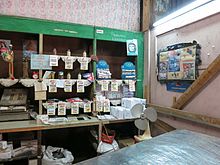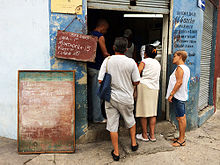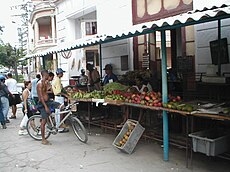
The economy of Cuba is a planned economy dominated by state-run enterprises. Most of the labor force is employed by the state. In the 1990s, the ruling Communist Party of Cuba encouraged the formation of worker co-operatives and self-employment. In the late 2010s, private property and free-market rights along with foreign direct investment were granted by the 2018 Cuban constitution. Foreign direct investment in various Cuban economic sectors increased before 2018. As of 2021, Cuba's private sector is allowed to operate in most sectors of the economy. As of 2023, public-sector employment was 65%, and private-sector employment was 35%, compared to the 2000 ratio of 76% to 23% and the 1981 ratio of 91% to 8%. Investment is restricted and requires approval by the government. In 2021, Cuba ranked 83rd out of 191 on the Human Development Index in the high human development category. As of 2012, the country's public debt comprised 35.3% of GDP, inflation (CDP) was 5.5%, and GDP growth was 3%. Housing and transportation costs are low. Cubans receive government-subsidized education, healthcare, and food subsidies.

A convenience store, bodega, convenience shop, corner store or corner shop is a small retail store that stocks a range of everyday items such as tea, coffee, groceries, fruits, vegetables, snacks, confectionery, soft drinks, ice creams, tobacco products, lottery tickets, over-the-counter drugs, toiletries, newspapers and magazines. In some jurisdictions, convenience stores are licensed to sell alcoholic drinks, although many jurisdictions limit such beverages to those with relatively low alcohol content, like beer and wine. The stores may also offer money order and wire transfer services, along with the use of a fax machine or photocopier for a small per-copy cost. Some also sell tickets or recharge smart cards, e.g. OPUS cards in Montreal or include a small deli. They differ from general stores and village shops in that they are not in a rural location and are used as a convenient supplement to larger stores.

The Meal, Ready-to-Eat (MRE) is a self-contained individual United States military ration used by the United States Armed Forces and Department of Defense. It is intended for use by American service members in combat or field conditions where other food is not available. MREs have also been distributed to civilians as humanitarian daily rations during natural disasters and wars.

The C-ration was a United States military ration consisting of prepared, canned wet foods. They were intended to be served when fresh or packaged unprepared food was unavailable, and survival rations were insufficient. It was replaced by the similar Meal, Combat, Individual (MCI) in 1958; its modern successor is the Meal, Ready-to-Eat (MRE).

A grocery store (AE), grocery shop (BE) or simply grocery is a foodservice retail store that primarily retails a general range of food products, which may be fresh or packaged. In everyday U.S. usage, however, "grocery store" is a synonym for supermarket, and is not used to refer to other types of stores that sell groceries. In the UK, shops that sell food are distinguished as grocers or grocery shops.

Rationing is the controlled distribution of scarce resources, goods, services, or an artificial restriction of demand. Rationing controls the size of the ration, which is one's allowed portion of the resources being distributed on a particular day or at a particular time. There are many forms of rationing, although rationing by price is most prevalent.

Hardtack is a type of dense biscuit or cracker made from flour, water, and sometimes salt. Hardtack is inexpensive and long-lasting. It is used for sustenance in the absence of perishable foods, commonly during long sea voyages, land migrations, and military campaigns. Along with salt pork and corned beef, hardtack was a standard ration for many militaries and navies from the 17th to the early 20th centuries.

Austerity in Israel was the policy of austerity imposed in the State of Israel from 1949 to 1959. It included rationing and other emergency measures to weather the economic crisis in the early days of statehood.

Consumer goods in the Soviet Union were usually produced by a two-category industry. Group A was "heavy industry", which included all goods that serve as an input required for the production of some other, final good. Group B was "consumer goods", final goods used for consumption, which included food, clothing and shoes, housing, and such heavy-industry products as appliances and fuels that are used by individual consumers. From the early days of the Stalin era, Group A received top priority in economic planning and allocation so as to industrialize the Soviet Union from its previous agricultural economy.

Rationing was introduced temporarily by the British government several times during the 20th century, during and immediately after a war.

The Special Period, officially the Special Period in the Time of Peace, was an extended period of economic crisis in Cuba that began in 1991 primarily due to the dissolution of the Soviet Union and the Comecon. The economic depression of the Special Period was at its most severe in the early to mid-1990s. Things improved towards the end of the decade once Hugo Chávez's Venezuela emerged as Cuba's primary trading partner and diplomatic ally, and especially after the year 2000 once Cuba–Russia relations improved under the presidency of Vladimir Putin.

Military chocolate has been a part of standard United States military rations since the original D-ration bar of 1937. Today, military chocolate is issued to troops as part of basic field rations and sundry packs. Chocolate rations served two purposes: as a morale boost, and as a high-energy, pocket-sized emergency ration. Military chocolate rations are often made in special lots to military specifications for weight, size, and endurance. The majority of chocolate issued to US military personnel is produced by The Hershey Company.
Mission Mercal, officially launched on 24 April 2003 is a Bolivarian Mission established in Venezuela under the government of Hugo Chávez. The Mission involves a state-run company called Mercados de Alimentos, C.A. (MERCAL), which provides subsidised food and basic goods through a nationwide chain of stores.
Rationing in the Soviet Union was introduced twice since its creation, both instances during periods of economical hardships.
Health in Cuba refers to the overall health of the population of Cuba. Like the rest of the Cuban economy, Cuban medical care suffered following the end of Soviet subsidies in 1991; the stepping up of the US embargo against Cuba at this time also had an effect.

Military rations, operational rations, or military provisions are goods issued to sustain the needs of military personnel. As their name suggests, military rations have historically been, and often still are, subject to rationing, with each individual receiving specific amounts from available supplies. Military-issued goods and the rationing of such goods has existed since the beginnings of organized warfare.

The Food Packet, Long Range Patrol was a freeze-dried dehydrated United States military ration used by the Department of Defense. Developed in 1964 and intended for wide adoption during the Vietnam War, its use was eventually limited to American special operations forces during long-range reconnaissance patrols, where bulky canned Meal, Combat, Individual (MCI) rations proved too heavy for extended missions on foot. The LRP had a cold-weather warfare equivalent, the Ration, Cold Weather (RCW).

The Meal, Combat, Individual (MCI) was a United States military ration of canned and preserved food, issued from 1958 to 1980. It replaced the earlier C-ration, which it was so similar to that it was often nicknamed the "C-ration", despite the term never being used officially. The MCI was eventually replaced by the Meal, Ready-to-Eat (MRE).

The Kerala State Civil Supplies Corporation Limited, abbreviated as and known better by its brand name Supplyco, is a Government of Kerala-owned company headquartered at Kochi, India. It acts as the execution arm of the Department of Food and Civil Supplies of the Government of Kerala. Founded in 1974, the company serves the purpose of governmental intervention in the retail market to control prices of essential commodities.




















